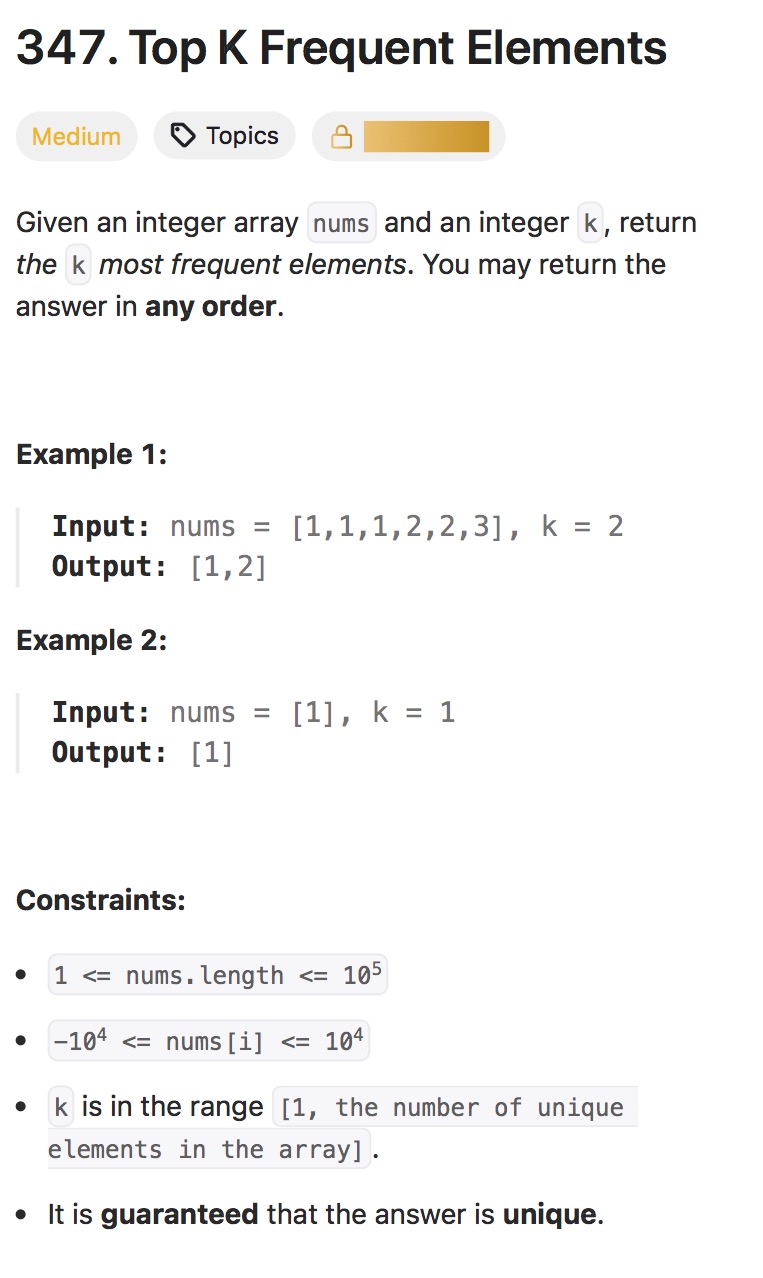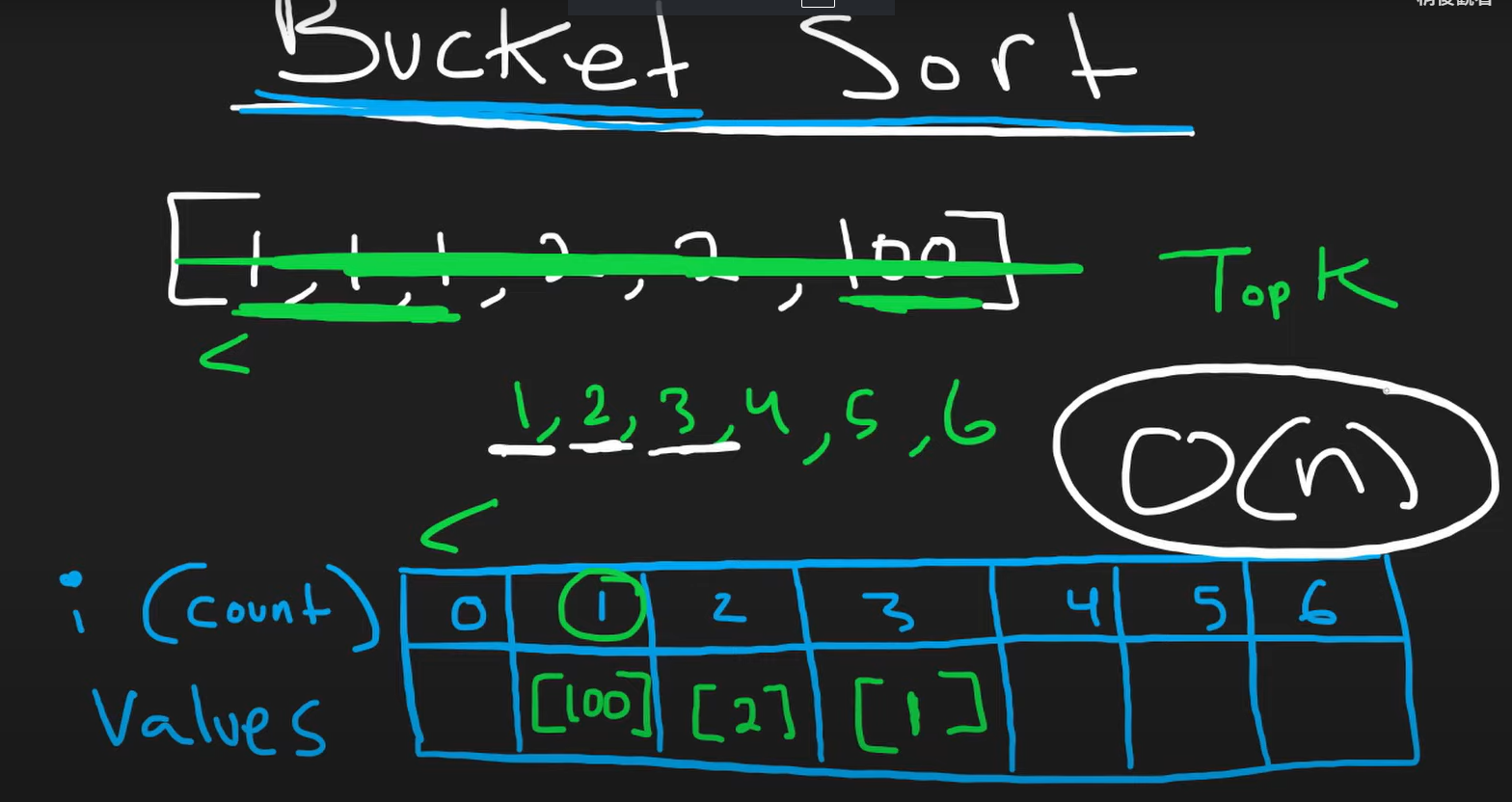Easy | Leetcode 347. Top K Frequent Elements
Given an integer array nums and an integer k, return the k most frequent elements. You may return the answer in any order.
LeetCode link: 點此進入LeetCode
NeetCode link: 點此進入NeetCode
Easy | Leetcode 347. Top K Frequent Elements
Question
Given an integer array nums and an integer k, return the k most frequent elements. You may return the answer in any order.
Solution
Solution 1: Sorting
解題概念:
- 用一個hashmap把每個元素跟他出現過的次數記錄起來。
- 由於Map無法排序,我們把Map轉為list,每個list的元素為一個陣列 [數字, 次數]。
- 對list的第二個元素(出現次數)做排序,由大到小。
- 最後拿出list中前K個元素的數字做為結果return。
程式碼:
1
2
3
4
5
6
7
8
9
10
11
12
13
14
15
16
17
18
19
20
21
22
23
24
25
26
27
28
29
30
31
32
33
34
35
public class Solution1 {
public int[] topKFrequent(int[] nums, int k) {
// 建立一個Hashmap
Map<Integer, Integer> map = new HashMap<>();
// 儲存數字與對應出現次數
for (int num: nums) {
map.put(num, map.getOrDefault(num, 0) + 1);
}
// 將Map轉為List,List每個元素為一個陣列(數字,出現次數)
List<int[]> list = new ArrayList<>();
// 遍歷Map中所有元素,並取出key, value
for (Map.Entry<Integer, Integer> entry: map.entrySet()) {
int[] arr = new int[2];
arr[0] = entry.getKey();
arr[1] = entry.getValue();
list.add(arr);
}
// 對list的出現次數做排序,降序
list.sort((a, b) -> Integer.compare(b[1], a[1]));
// 將前K個元素取出其數字
int[] result = new int[k];
for (int i = 0; i < k; i++) {
result[i] = list.get(i)[0];
}
return result;
}
}
複雜度分析:
- Time complexity: $O(n logn)$
- 遍歷num所有元素存入map:$O(n)$
- 將map轉為list:$O(m)$,m為map的key個數,最壞為 $O(n)$
- 排序:$O(m logm)$,最壞為 $O(n logn)$
- 取出前K個元素:$O(k)$ => 總共:$O(n logn)$
- Space complexity: $O(n)$
- 儲存map:$O(m)$,最壞 $O(n)$
- 儲存list:$O(m)$,最壞 $O(n)$
- 儲存結果:$O(k)$ => 總共:$O(n)$
Solution2: Min heap
解題概念:
- 用一個hashmap把每個元素跟他出現過的次數記錄起來。
- 把Map轉為Heap,每個heap的元素為一個陣列 [數字, 次數]。(建立heap的時候記得設定其排序:by 出現次數)
- 維持heap大小為K,若超過,把最小的移除,可以保證heap裡面存的是前K大的元素(大小是針對出現次數)
- 將heap中所有元素一一拿出來,並取出其數字。
程式碼:
1
2
3
4
5
6
7
8
9
10
11
12
13
14
15
16
17
18
19
20
21
22
23
24
25
26
27
28
29
30
31
public class Solution2 {
public int[] topKFrequent(int[] nums, int k) {
// 建立一個Hashmap
Map<Integer, Integer> map = new HashMap<>();
// 儲存數字與對應出現次數
for (int num: nums) {
map.put(num, map.getOrDefault(num, 0) + 1);
}
// 建立一個heap,每個元素為一個陣列,指定以陣列第二個元素做排序(出現次數)
PriorityQueue<int[]> min_heap = new PriorityQueue<>((a, b) -> Integer.compare(a[1], b[1]));
// 將Map中每組資料加入heap
for (Map.Entry<Integer, Integer> entry: map.entrySet()) {
min_heap.offer(new int[]{entry.getKey(), entry.getValue()});
// heap維持前K大的元素
if (min_heap.size() > k) {
min_heap.poll();
}
}
// 將heap中前K個元素取出其數字
int[] result = new int[k];
for (int i = 0; i < k; i++) {
result[i] = min_heap.poll()[0];
}
return result;
}
}
複雜度分析:
- Time complexity: $O(n logk)$
- 遍歷num所有元素存入map:$O(n)$
- 將map中元素加入heap(heap大小為k):每次為 $O(log k)$,總共最多n次:$O(n logk)$。
- 從heap中取出元素:每次為 $O(log k)$,總共k次:$O(k logk)$。
- Space complexity: $O(n + k)$
- Hashmap:$O(n)$
- Heap:最多k個元素,每個元素長度為2陣列:$O(k)$;結果陣列:$O(k)$。
Solution3: Bucket Sort
解題概念:
- 用一個hashmap把每個元素跟他出現過的次數記錄起來。
- 建立一個frequncy array,index是出現次數,value是對應到這個出現次數的數字(為一個List)
- array長度為num個數+1,因為若所有數字都是同一個,最大的count即為num個數。
- 遍歷這個frequncy array,從index (count)最大開始,若其value list有數字,將他加入reuslt陣列。
- result陣列個數為k的時候,返回結果。
程式碼:
1
2
3
4
5
6
7
8
9
10
11
12
13
14
15
16
17
18
19
20
21
22
23
24
25
26
27
28
29
30
31
32
33
34
35
36
37
38
public class Solution3 {
public int[] topKFrequent(int[] nums, int k) {
// 建立一個Hashmap
Map<Integer, Integer> map = new HashMap<>();
// 儲存數字與對應出現次數
for (int num: nums) {
map.put(num, map.getOrDefault(num, 0) + 1);
}
// 建立freq array,共有num個數+1個元素
List<Integer>[] freq = new List[nums.length + 1];
for (int i = 0; i < freq.length; i ++) {
freq[i] = new ArrayList<>(); // 初始化:值為空list
}
// 將map結果依序加入freq陣列中
// index=出現次數;value=出現該次數的數字list
for (Map.Entry<Integer, Integer> entry: map.entrySet()) {
freq[entry.getValue()].add(entry.getKey()); // 將數字加入list中
}
int[] result = new int[k];
int index = 0;
// 從出現次數最大開始,若他對應到的數字list有值,加入result陣列
for (int i = freq.length - 1; i >= 0; i--) {
for (int num: freq[i]) {
result[index] = num;
index++;
}
// 直到陣列元素=k
if (index == k) {
return result;
}
}
return result;
}
}
複雜度分析:
- Time complexity: $O(n)$
- 建立map:$O(n)$
- 建立bucket:$O(n)$
- 遍歷bucket:$O(n)$
- Space complexity: $O(n)$
- HashMap大小:$O(n)$
- 桶空間最多 n+1:$O(n)$
- 結果陣列大小為 k:$O(k)$
本文章以 CC BY 4.0 授權


